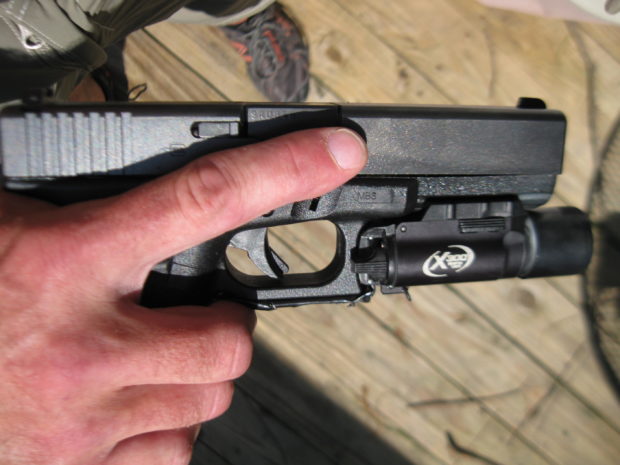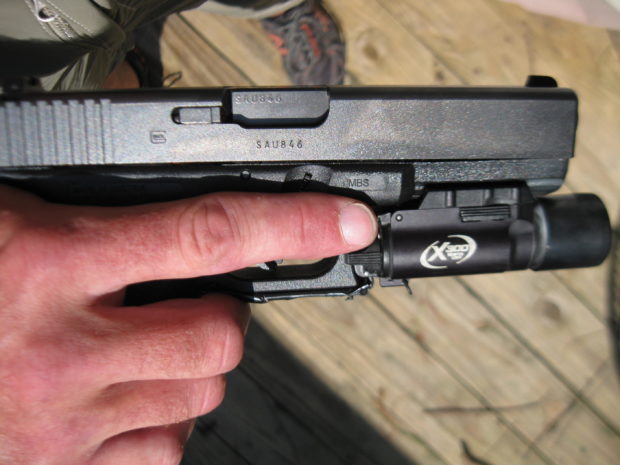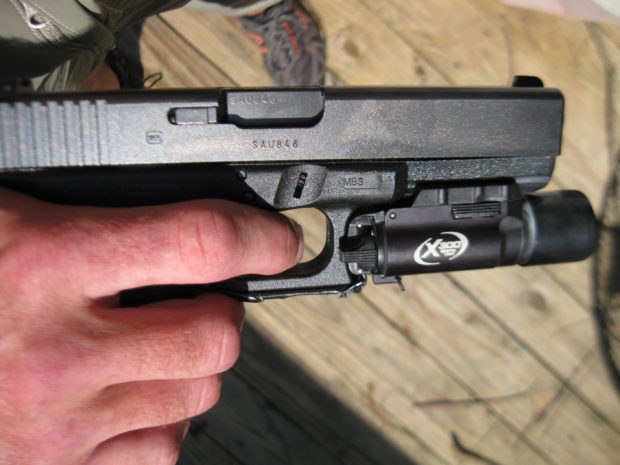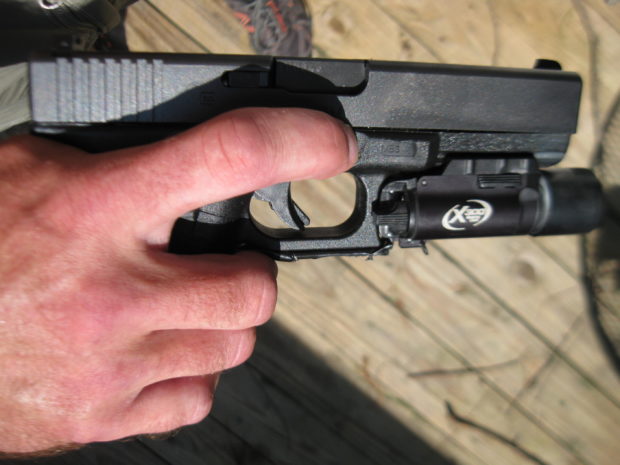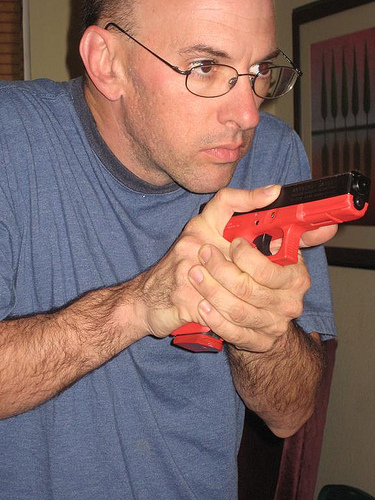Ten years ago, an experienced handgun instructor contacted me to help him reconstruct the events of an accidental shooting. This instructor shot himself while reholstering after doing a demonstration during a basic concealed handgun class.
I know what you are thinking….
“He shouldn’t have had his finger on the trigger when he was putting the gun in the holster.”
or
“I bet he was using a Blackhawk Serpa holster.”
Nope. Neither was true.
He is an experienced instructor and competitive shooter, receiving professional training from the best in the business. He has good weapon handling skills. I have seen him draw and shoot and know that he doesn’t casually keep his finger on the trigger while holstering. It was a somewhat baffling dilemma. And that’s why he contacted me.
He told me:
“Greg, I know how guns work. I’m not blaming this on the gun or the holster. I know that I had to have pulled the trigger for the gun to go off. But I’ve been doing this a long time and I know not to have my finger on the trigger when I’m not actually shooting. I just don’t understand how it happened.”
I met him in order to try to reconstruct what happened. He wore the same gun (unloaded) and holster and walked me through the events of the day leading up to the shooting.
He was doing a demonstration of close quarters retention shooting for his CCW class. Standing in close proximity to a cardboard target, he drew his gun, fired a couple rounds from retention and reholstered. He explained that he repeated the demonstration and fired a few more shots from retention. The then thought he should demonstrate the value of keeping his non-gun hand up to fend off any threat that might still be coming if the shots didn’t take effect. While reholstering, he reached out with his left hand and grabbed the target in an effort to show how the off hand can be used defensively. His gun fired.
The muzzle of his gun (Glock 35 in .40 s&W) was oriented almost straight down, near the mouth of his inside the waistband holster. The FMJ round split his belt and then entered the outside of his right hip. The round traveled the full length of his right leg, exiting on the inside of his right calf. Miraculously, the bullet didn’t hit any major arteries, bones, or nerves. He spent the night in the hospital for observation but was discharged the next morning with no complications. The wound is now almost completely healed with only a little minor numbness near the exit wound.
I had a suspicion that I knew why the accidental discharge had occurred. As he demonstrated the sequence of events with an unloaded gun, I received further confirmation that my suspicions were correct. As he drew and holstered, he had excellent trigger finger discipline. His finger never touched the trigger unless he was in the act of firing. But I did notice a common shooting error. When his finger was off the trigger, it was generally placed along the outside of the trigger guard. Check out the picture below.
Many shooters hold their fingers this way when not firing. They believe that since the finger is not on the trigger, an accidental discharge won’t occur. In general, they are correct. But most shooters don’t know that certain situations can cause an involuntary hand clenching. The tightening of the hand causes a contraction of all of the fingers with a force up to 30 lbs. (the Glock trigger pull weight is around 6 lbs.) and cannot be consciously controlled.
Take a look at the picture again. Where do you think the trigger finger will end up if there is an involuntary hand clench? You guessed it…on the trigger.
So what causes these involuntary hand clenches?
The three most commonly identified causes of involuntary hand clenching have been extensively studied. They are as follows:
1) Postural Imbalance. When the shooter loses balance or trips, his hands will clench.
2) Startle Effect. When the shooter is under stress and surprised, there will often be a hand clench.
3) Interlimb Interaction. Under stress, when the non gun hand closes violently, the gun hand will clench, spontaneously duplicating the actions of the non-gun hand.
Just how common is this phenomenon? It’s way more common than most shooters realize. A study of all firearms discharges in Federal Agencies (FBI, DEA, ATF) from 2000-2003 found that out of 267 total discharges, 102 of them were accidental discharges. Weapon handling skills and trigger finger discipline are universally lacking, even among supposedly “well trained” individuals.
Which of the events above likely contributed to my experienced instructor friend shooting himself? We’ll never know for sure, but a likely candidate is the Interlimb Interaction issue. When he reached out to violently grab the target with his left hand, his right hand also spontaneously clenched. With his finger positioned on the outside of the trigger guard, the clench drove his trigger finger straight back onto the trigger.
There are a few other situations that can contribute to involuntary hand clenching. A study conducted by the German National Police identified the following situations when officers were most likely to touch their triggers unintentionally:
– Jumping
– Loss of balance
– Single Leg Kicks
– Pushing or Pulling with the non-gun hand
In addition to the above, American research by the Force Science Institute has identified other causes of unintentional discharges if officers’ fingers are on or near the trigger:
– The suspect or another party striking or touching the gun arm or hand
– Hand confusion- when the hands are crossed (think Harries Flashlight position) it is difficult to differentiate between the two under stress. An officer might be trying to turn on the flashlight, but accidentally mixes up his hands and pulls the trigger instead.
– Contra-lateral muscular contraction (the non gun side hand or leg moves violently)
– A “YIP”- defined by a sudden spasmodic jerk of the hand or forearm muscles. It’s been intensively studied in the context of figuring out why pro golfers miss putts, but it is now being applied to research about accidental shootings. Yips occur more frequently under high stress and heart rates
Accidental discharges from faulty trigger finger positioning can be prevented. While we can’t do anything to stop the hand from involuntarily clenching, if we position the trigger finger properly, the trigger will not be engaged.
The most important training consideration is keeping the finger off the trigger unless you are in the actual act of firing. Don’t have your finger on the trigger while searching a building or holding a suspect at gunpoint. Keeping the trigger finger in register (off the trigger) only adds an average of .15 seconds to the shooter’s firing time. That’s an inconsequential amount of time in a gunfight, but the safety it promotes is invaluable.
There are two good positions in which to keep the finger when not firing. The one I use and teach is to place the trigger finger as high as possible on the slide without disturbing the grip. If the hands clench with the finger in this position, it isn’t likely to contact the trigger.
An alternate trigger finger position was first advocated by Massad Ayoob. Mas likes placing the finger fairly high on the frame with the trigger finger bent or curled. The bent position causes the finger to curl onto the frame if the hands are clenched. This position also gives the shooter a little more strength to resist a gun grab attempt.
The late firearms instructor Paul Gomez advocated combining the two tactics.
In either position it is important to find some sort of tactile reference. You should strive for consistency by trying to feel the same spot with your trigger finger at all times. The spot will vary depending on trigger finger length and the gun you are using. For me, feeling the bottom edge of the ejector port let’s me know my finger is in the right place. On Glock handguns, the slide lock lever makes a good indicator for the Ayoob position.
No matter what finger position you favor, you must practice it every time you shoot in order to build the familiarity necessary to default to a correct position under stress.
As a side note, my wounded instructor friend realized another hole in his training. He had no trauma medical supplies or training to use them at the rural range where he was holding his class. It took the ambulance nearly 25 minutes to arrive. If his wound had been more serious, he likely would have bled to death in that time frame. He now has a complete trauma medicine kit and is getting training on how to use it. All shooters should do the same.
My friend learned a couple of important lessons the day that he shot himself. Gunshot wounds hurt. It’s best to prevent them by properly positioning the trigger finger. If, despite your efforts, someone is accidentally shot on your range, you better know how to keep him alive until the ambulance arrives.
My friend learned these lessons the hard way. It’s up to you to learn for yourself. Those of you who are smart will pay attention to the points highlighted in this article. The rest of you may be in for a more painful and costly lesson.

